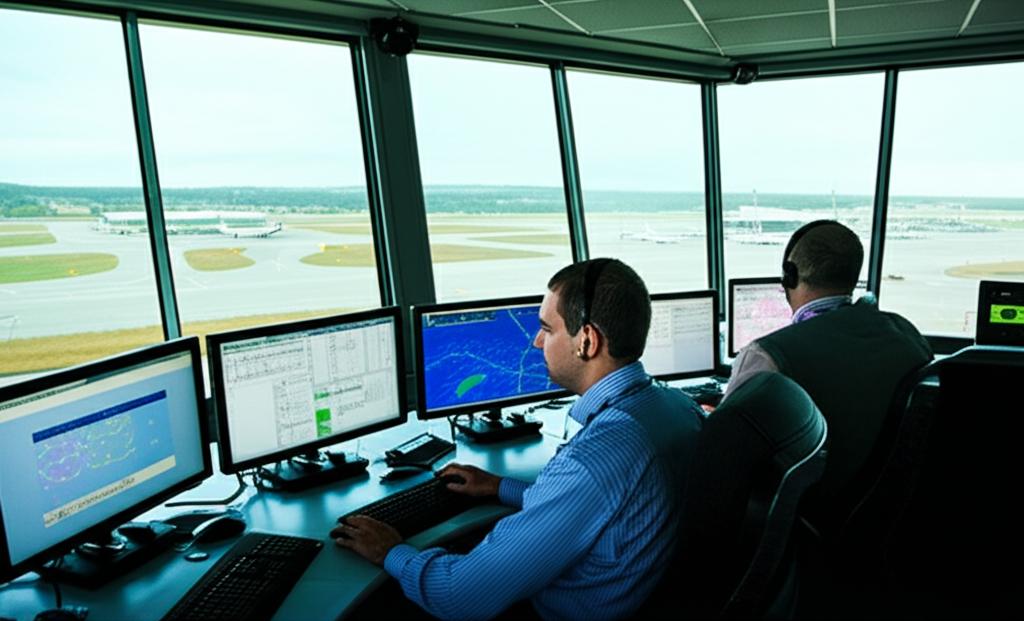
Have you ever looked up at the sky and wondered how hundreds of aeroplanes manage to navigate the crowded airspace safely? The answer lies in the skilled hands and sharp minds of air traffic controllers. This article delves into the world of air traffic control through the lens of a fictional character, Adam Gillespie, providing insights into the challenges, responsibilities, and rewards of this critical profession. We’ll explore what it takes to become an air traffic controller in the UK, the technology they use, and the crucial role they play in ensuring the safety and efficiency of air travel.
Air traffic control is more than just a job; it’s a high-stakes profession that demands precision, quick thinking, and unwavering focus. From managing routine flights to handling emergencies, air traffic controllers are the unsung heroes who keep our skies safe. Let’s step into the control tower and gain a deeper understanding of their world.
The Role of an Air Traffic Controller
Air traffic controllers are responsible for directing aircraft safely and efficiently within a specific airspace. Their primary goal is to prevent collisions between aircraft and to organise and expedite the flow of air traffic. This involves monitoring aircraft positions, issuing instructions to pilots, and coordinating with other air traffic control units. The job requires constant vigilance and the ability to make critical decisions under pressure. It is a job that is not for the faint of heart, but rather for the determined and quick thinking.
In the UK, air traffic controllers work for NATS (National Air Traffic Services), which provides air traffic control services for both civil and military aviation. They are stationed at various airports and control centres across the country, managing different sectors of airspace. These sectors are divided into areas of responsibility. Each controller must be well-versed in the regulations, procedures, and technology used to manage air traffic within their assigned area.
Responsibilities and Duties
The responsibilities of an air traffic controller are diverse and demanding. They include:
- Monitoring Aircraft: Tracking the position, altitude, and speed of aircraft using radar and other surveillance systems.
- Issuing Instructions: Providing pilots with clear and concise instructions regarding heading, altitude, and speed adjustments.
- Coordinating Traffic: Managing the flow of air traffic to prevent congestion and delays.
- Handling Emergencies: Responding to emergency situations, such as aircraft malfunctions or medical emergencies, and coordinating with emergency services.
- Communicating with Pilots: Maintaining constant communication with pilots to provide updates on weather conditions, traffic situations, and other relevant information.
- Collaborating with Other Controllers: Coordinating with other air traffic control units to ensure a seamless transition of aircraft between different sectors of airspace.
These responsibilities are not taken lightly, as the safety of all those on board and on the ground depend on the decisions made by the controllers in the tower.
Controllers also use various tools and technologies to aid them in their duties, including radar displays, communication systems, and computerised flight data processing systems. These tools provide them with real-time information about aircraft positions and flight plans, allowing them to make informed decisions and manage traffic effectively. The integration of these technologies is crucial for maintaining safety and efficiency in the increasingly busy skies.
The Importance of Precision and Communication
Precision and clear communication are paramount in air traffic control. A minor error or misunderstanding can have catastrophic consequences. Air traffic controllers must be able to think quickly, assess situations accurately, and communicate effectively under pressure. They must also be able to maintain their composure in stressful situations and make sound judgments, even when faced with incomplete information. The ability to remain calm and focused is a key attribute of a successful air traffic controller.
Effective communication involves using standard phraseology and protocols to ensure that instructions are clear and unambiguous. Pilots and controllers must understand each other perfectly, even when communicating over noisy radio channels. Regular training and simulations are conducted to reinforce these communication skills and ensure that controllers are prepared to handle any situation that may arise. The use of standardised procedures helps to minimise the risk of misunderstandings and errors.
Becoming an Air Traffic Controller in the UK
Becoming an air traffic controller in the UK is a challenging but rewarding career path. The selection process is rigorous, and the training is intensive, but those who succeed are rewarded with a highly respected and well-compensated profession. The process involves several stages, from initial application to on-the-job training, each designed to assess the candidate’s suitability for the role.
NATS is the primary provider of air traffic control services in the UK and is responsible for recruiting and training new controllers. The application process is highly competitive, and only a small percentage of applicants are selected for training. Successful candidates must possess a unique combination of skills, including spatial reasoning, problem-solving abilities, and excellent communication skills. It is a profession that demands the best, and the selection process reflects this.
Entry Requirements and Training
The entry requirements for becoming an air traffic controller in the UK typically include:
- Age: Applicants must be at least 18 years old.
- Education: A good standard of education, usually demonstrated by GCSEs and A-levels or equivalent qualifications.
- Skills: Strong spatial reasoning, problem-solving, and communication skills.
- Medical Fitness: Meeting the required medical standards, including eyesight and hearing tests.
Once selected, candidates undergo a comprehensive training program that combines classroom instruction with practical simulations. The training covers a wide range of topics, including air law, meteorology, navigation, and air traffic control procedures. Trainees learn how to use radar systems, communication equipment, and other tools used in air traffic control. The training is designed to prepare them for the challenges of managing real-world air traffic.
The training program typically lasts for several months and includes both theoretical and practical components. Trainees spend time in simulated control towers, practicing their skills under the supervision of experienced instructors. They learn how to handle routine traffic situations, as well as emergency scenarios. The goal is to develop their decision-making abilities and their ability to remain calm under pressure. Successful completion of the training program leads to certification as an air traffic controller.
The Challenges of the Job
Air traffic control is a demanding profession that presents numerous challenges. Controllers must be able to handle high levels of stress, work irregular hours, and make critical decisions under pressure. They must also stay up-to-date with the latest technologies and procedures, as the aviation industry is constantly evolving. The job requires a high degree of commitment and dedication.
One of the biggest challenges is managing traffic during peak hours or adverse weather conditions. Controllers must be able to prioritise flights, adjust routes, and coordinate with other air traffic control units to minimise delays and ensure safety. They must also be prepared to handle unexpected events, such as aircraft malfunctions or medical emergencies. The ability to adapt to changing circumstances and make quick decisions is essential for success in this profession.
Technology and Innovation in Air Traffic Control
Technology plays a vital role in modern air traffic control. Advanced radar systems, communication networks, and computerised flight data processing systems are essential tools for managing air traffic safely and efficiently. These technologies provide controllers with real-time information about aircraft positions, weather conditions, and other relevant data, allowing them to make informed decisions and manage traffic effectively. The ongoing development and implementation of new technologies are crucial for improving the safety and efficiency of air travel.
In recent years, there has been a growing emphasis on automation and data integration in air traffic control. New systems are being developed to automate routine tasks, such as flight planning and conflict detection, freeing up controllers to focus on more complex and critical tasks. Data integration allows controllers to access a wide range of information from different sources, providing them with a more comprehensive view of the airspace. These advancements are helping to improve the efficiency and safety of air traffic control.
The Use of Radar and Surveillance Systems
Radar is the primary tool used by air traffic controllers to monitor the position of aircraft. Radar systems emit radio waves that bounce off aircraft, providing controllers with information about their location, altitude, and speed. Advanced radar systems can also track weather patterns and identify potential hazards, such as thunderstorms or icing conditions. The information provided by radar is essential for maintaining situational awareness and preventing collisions.
In addition to radar, air traffic controllers also use other surveillance systems, such as Automatic Dependent Surveillance-Broadcast (ADS-B). ADS-B is a technology that allows aircraft to broadcast their position, altitude, and other information to air traffic control and other aircraft. This provides controllers with a more accurate and complete picture of the airspace, improving safety and efficiency. The use of ADS-B is becoming increasingly widespread, and it is expected to play a major role in the future of air traffic control.
Future Trends in Air Traffic Control Technology
The future of air traffic control is likely to be shaped by several key trends, including:
- Increased Automation: Automation will play an increasingly important role in air traffic control, automating routine tasks and freeing up controllers to focus on more complex and critical tasks.
- Data Integration: Data integration will allow controllers to access a wide range of information from different sources, providing them with a more comprehensive view of the airspace.
- Remote Towers: Remote towers, which allow controllers to manage air traffic from a remote location, are becoming increasingly common. These towers can provide cost-effective air traffic control services to smaller airports.
- Unmanned Aircraft Systems (UAS) Integration: Integrating UAS, or drones, into the national airspace system is a major challenge. New technologies and procedures are being developed to ensure the safe and efficient integration of drones into the airspace.
These trends reflect the ongoing efforts to improve the safety, efficiency, and sustainability of air travel. As technology continues to evolve, air traffic control will become even more sophisticated and effective. The integration of new technologies will require ongoing training and adaptation for air traffic controllers, ensuring that they are equipped to manage the challenges of the future.
A Day in the Life of Adam Gillespie
Let’s imagine a typical day for our fictional air traffic controller, Adam Gillespie, working at a busy airport in the UK. Adam’s day begins with a briefing from the outgoing shift, where he receives updates on current traffic conditions, weather forecasts, and any ongoing issues. He then takes his position in the control tower, ready to manage the flow of aircraft arriving and departing from the airport. The day is filled with constant communication, quick decision-making, and unwavering focus.
Throughout the day, Adam monitors radar displays, communicates with pilots, and coordinates with other air traffic control units. He manages routine flights, handles unexpected delays, and responds to emergency situations. He must be able to think on his feet, assess situations accurately, and make sound judgments under pressure. Despite the challenges, Adam finds satisfaction in knowing that he plays a crucial role in ensuring the safety of air travel. He also knows that he needs to be aware of changes to his business, so he keeps an eye out for the latest financial news.
Morning Shift
Adam arrives at the control tower at 6:00 AM, ready to start his morning shift. The first task is to receive a briefing from the night shift controllers. He learns about any overnight incidents, ongoing maintenance, and anticipated weather conditions. Armed with this information, Adam prepares for the morning rush, when the airport sees a surge in departing flights. He makes sure all systems are functioning correctly and reviews the flight schedules.
As the morning progresses, Adam manages a steady stream of aircraft taxiing, taking off, and approaching the airport. He provides pilots with instructions on headings, altitudes, and speeds, ensuring that each aircraft maintains a safe distance from others. He also coordinates with ground control to manage the movement of aircraft on the taxiways. The constant communication and coordination require unwavering focus and attention to detail. The job demands a unique blend of technical skill and human interaction.
Afternoon Challenges
The afternoon brings new challenges, as weather conditions begin to change. A line of thunderstorms is approaching the airport, threatening to disrupt flight operations. Adam works with the meteorologists to assess the severity of the storms and their potential impact on air traffic. He begins to reroute flights around the storms, coordinating with other air traffic control units to minimise delays. The ability to anticipate and respond to changing weather conditions is a critical skill for air traffic controllers.
During the afternoon, Adam also has to deal with an aircraft experiencing a minor mechanical issue. The pilot declares an emergency and requests priority landing. Adam clears the runway and coordinates with emergency services to ensure a safe landing. He remains calm and composed, providing the pilot with clear and concise instructions. The successful resolution of the emergency highlights the importance of training and preparation in air traffic control. It also demonstrates the critical role that controllers play in ensuring the safety of passengers and crew. For any travel businesses that need to transport supplies, it’s important to find the best haulage companies.
The Future of Air Traffic Control in the UK
The future of air traffic control in the UK is likely to be shaped by several key factors, including technological advancements, increasing air traffic volume, and evolving regulatory requirements. NATS is investing heavily in new technologies and procedures to improve the safety and efficiency of air traffic control. These investments are aimed at modernising the UK’s airspace and ensuring that it can meet the demands of the future. The goal is to create a more seamless and efficient air transportation system.
One of the key priorities is to integrate new technologies, such as satellite-based navigation and data communication systems, into the air traffic control system. These technologies will provide controllers with more accurate and reliable information about aircraft positions and flight plans, allowing them to manage traffic more efficiently. NATS is also working to develop new procedures for managing air traffic, such as performance-based navigation, which allows aircraft to fly more direct routes and reduce fuel consumption. These efforts are aimed at reducing the environmental impact of aviation and improving the sustainability of air travel.
Addressing Future Challenges
The UK’s air traffic control system faces several challenges in the coming years, including:
- Increasing Air Traffic Volume: Air traffic volume is expected to continue to grow in the coming years, placing increasing demands on the air traffic control system.
- Technological Advancements: Keeping up with the latest technological advancements and integrating them into the air traffic control system is a major challenge.
- Cybersecurity Threats: Protecting the air traffic control system from cybersecurity threats is a growing concern.
- Environmental Concerns: Reducing the environmental impact of aviation is a key priority.
To address these challenges, NATS is working to develop innovative solutions and strategies. These include investing in new technologies, improving training programs, and collaborating with other stakeholders in the aviation industry. The goal is to create a more resilient and sustainable air traffic control system that can meet the demands of the future. The success of these efforts will depend on the ability of NATS to adapt to changing circumstances and embrace new technologies.
The Importance of Continued Training and Development
Continued training and development are essential for air traffic controllers in the UK. The aviation industry is constantly evolving, and controllers must stay up-to-date with the latest technologies, procedures, and regulations. NATS provides ongoing training and development opportunities for its controllers, ensuring that they are equipped to manage the challenges of the future. This includes refresher courses, simulator training, and opportunities to learn about new technologies.
The training programs are designed to enhance controllers’ skills and knowledge, improve their decision-making abilities, and promote a culture of safety. Controllers are encouraged to participate in regular training exercises and simulations, which allow them to practice their skills in a safe and controlled environment. The emphasis on continuous learning and development is crucial for maintaining the highest standards of safety and efficiency in air traffic control. It also helps to ensure that controllers are prepared to handle any situation that may arise, from routine traffic management to emergency response.
Conclusion
The life of an air traffic controller, exemplified by our fictional Adam Gillespie, is one of immense responsibility and constant vigilance. From managing routine flights to handling emergencies, these professionals play a critical role in ensuring the safety and efficiency of air travel. The job demands precision, quick thinking, and unwavering focus. As technology continues to evolve and air traffic volume increases, the challenges faced by air traffic controllers will only grow. However, with continued training, innovation, and dedication, they will continue to keep our skies safe.
The insights from the control tower reveal a world of complex systems, demanding procedures, and highly skilled individuals. Air traffic controllers are the unsung heroes of the aviation industry, working tirelessly behind the scenes to ensure that millions of passengers reach their destinations safely. Next time you’re on a flight, take a moment to appreciate the work of these dedicated professionals. What innovative technologies do you think will have the biggest impact on air traffic control in the next decade?




